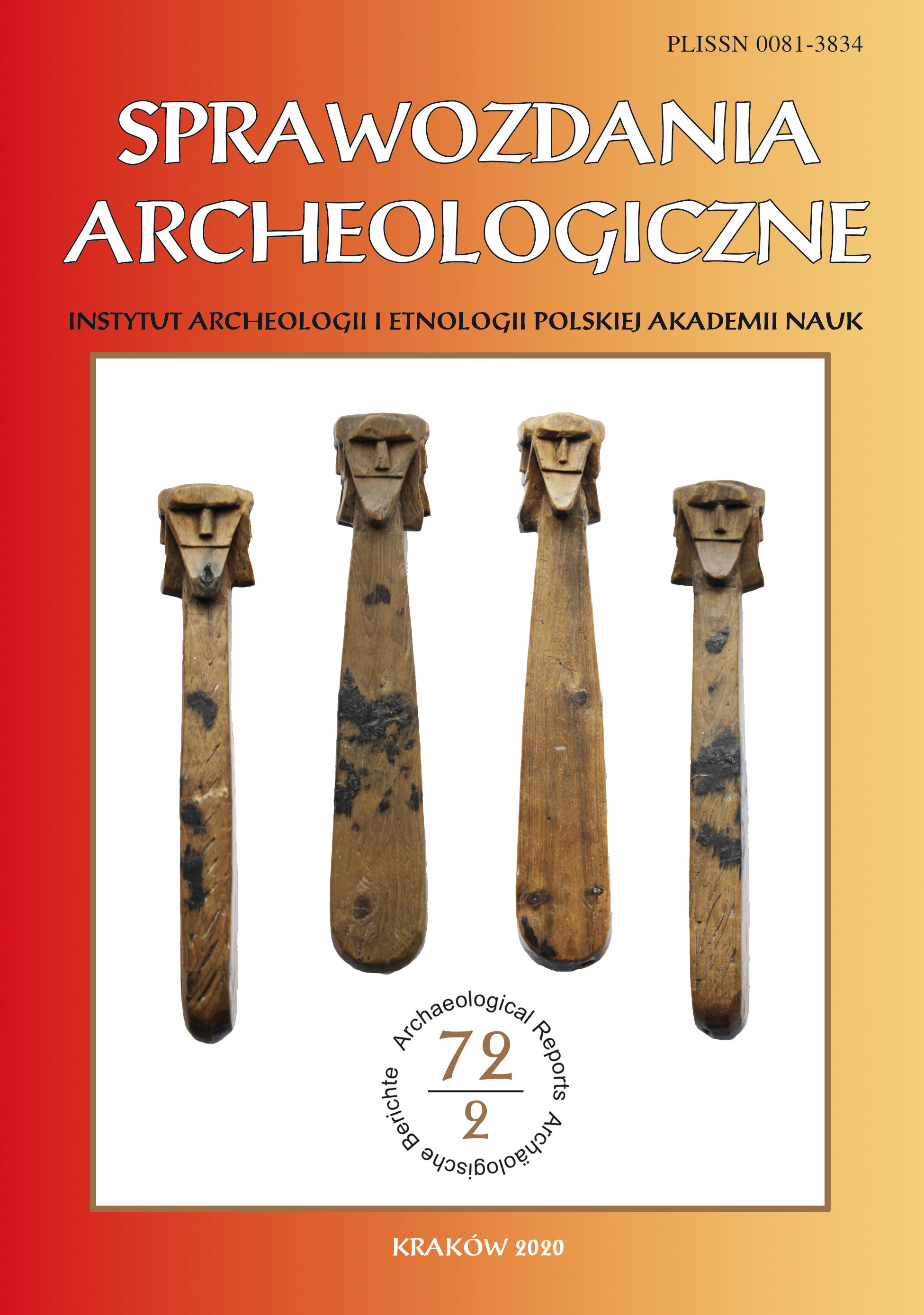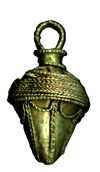Journeys of the mind: cognitive landscapes, symbolic dialects, and networked identities in the European Neolithic
DOI:
https://doi.org/10.23858/SA/72.2020.2.2260Słowa kluczowe:
cognitive landscapes, symbolic dialects, Cucuteni culture, painted pottery, wave medallions, cultural dialectsAbstrakt
Although the notion that the past was populated by cultural spheres containing relatively homogenous populations is pervasive, nuanced considerations of intra-culture variability allow for the recognition of local or regional identities that were simultaneously connected to but distinct from an overarching cultural sphere. This requires the identification of multiple interrelated cultural constituents and the recognition of a kind of cultural layering in which the identity or identities salient for members of a particular group are conceptualized as consisting of variably articulating categories that interact with and depend upon each other. Our approach to cultural variability and identity construction is based on this view and posits that cultural spheres studied in archaeological contexts can be divided into distinct but related cultural subgroups or dialects based on variations in material cultural data and studied independently or comparatively.
Pobrania
Bibliografia
Bailey D. W. 2005. Prehistoric Figurines: Representation and Corporeality in the Neolithic. New York: Routledge. DOI: https://doi.org/10.4324/9780203392454
Bailey D. W., Alasdair W. R. and Cummings V. 2005. (Un)Settling the Neolithic. Oxford: Oxbow.
Bakhtin M. M. 1981. The Dialogic Imagination. Austin: University of Texas Press.
Bohnemeyer J. 2006. Semantic typology: the crosslinguistic study of semantic categorization. Proceedings of CIFCL 10 Lectures, Beihang University.
Boyarin J. 1993. The Ethnography of Reading. Berkeley: University of California Press. DOI: https://doi.org/10.1525/9780520913431
Branton N. 2009. Landscape approaches in historical archaeology: The archaeology of places. In T. Majewski and D. Gaimster (eds), International Handbook of Historic Archaeology. New York: Springer. DOI: https://doi.org/10.1007/978-0-387-72071-5_4
Burdo N., Videiko M., Chapman J. and Gaydarska B. 2013. Houses in the archaeology of the Trypillia-Cucuteni groups. In D. Hofmann and J. Smyth (eds), Tracking the Neolithic house in Europe. New York: Springer, 95-115.
Chapman J. 2000. Fragmentation in archaeology: people, places, and broken objects in the prehistory of South Eastern Europe. London: Routledge.
Chomsky N. 1957. Syntactic structures. The Hague: Mouton & Co. DOI: https://doi.org/10.1515/9783112316009
Ciuk K. ed. 2008. Mysteries of ancient Ukraine: The remarkable Trypilian Culture 5400-2700 BC. Toronto: Royal Ontario Museum.
Constantinescu B., Bugoi R., Pantos E. and Popovici D. 2007. Phase and chemical composition analysis of pigments used in Cucuteni Neolithic painted ceramics. Documenta Praehistorica 34, 281-288.
Delle J. A. 1998. An Archaeology of social space: Analyzing coffee plantations in Jamaica’s Blue Mountains. New York: Plenum Press. DOI: https://doi.org/10.1007/978-1-4757-9159-4
Derrida J. 1977. Of grammatology. Baltimore: The Johns Hopkins University Press.
Diachenko A. 2019. Does the social field cause or accelerate cultural changes? In S. Kadrow and J. Müller (eds), Habitus? The social dimension of technology and transformation. Leiden: Sidestone Press, 71-86.
Diachenko A. and Menotti F. 2012. The gravity model: monitoring the formation and development of the Tripolye culture giant-settlements in Ukraine. Journal of Archaeological Science 39(4), 2810-2817.
Dumitrescu V. 1979. Arta Culturii Cucuteni. Bucureşti: Editura Meridiane.
Ellis L. 1984. The Cucuteni-Tripolye Culture: A study in technology and the origins of complex society (= BAR International Series 217). Oxford: BAR Publishing. DOI: https://doi.org/10.30861/9780860542797
Florescu A. 1966. Sistemul de Fortificare al Aşezărilor Cucuteniene din Moldova. Archeologia Moldovei 4:23-37.
Gallagher S. 2013. The socially extended mind. Cognitive Systems Research 25-26, 4-12.
Gallagher S. and Crisafi A. 2009. Mental institutions. Topoi 28(1), 45-51.
Gimbutas M. 1970. Proto-Indo-European Culture: The Kurgan Culture during the fifth, fourth, and third millennia B.C. In G. Cardona, H. M. Hoenigswald and A. Senns (eds), Indo-European and Indo-Europeans: Papers. Philadelphia: University of Pennsylvania Press, 155-197.
Gimbutas M. 1972. The Neolithic cultures of the Balkan Peninsula. In H. Birnbaum and S. Vryonis (eds), Aspects of the Balkans: Continuity and change. Paris: The Hague. DOI: https://doi.org/10.1515/9783110885934-002
Gimbutas M. 1973. Old Europe c. 7000-3500 B.C.: The Earliest European civilization before the infiltration of the Indo-European peoples. Journal of Indo-European Studies 1, 11-20.
Gimbutas M. 1982. The gods and godesses of Old Europe: 7000-3500 BC. Berkeley and Los Angeles: University of California Press.
Hanks W. F. 1989. Text and textuality. Annual Review of Anthropology 18, 95-127.
Harper T. K. 2013. The effect of climatic variability on population dynamics of the Cucuteni-Tripolye cultural complex and the rise of the Western Tripolye giant-settlements. Chronika 3, 8-46.
Hudson K. M. 2013a. Text and textuality in Ulúa iconography. Anthropology: Bachelors to Docto-rates 1, 2-20.
Hudson K. M. 2013b. Reading writing and the arithmetic of meaning: syntax and reading as social process. SUNY Buffalo Graduate Romance Studies Journal Special Issue: Plasticity 3D, 67-91.
Hudson K. M. 2014. Sherd stories: ceramic collections as archives for archaeological analysis. Archaeological Review from Cambridge: The Archive Issue 29(2), 164-178.
Hudson K. M. 2015. Edmund Leach and the rise of Cultural Polyvocality: A case study from the Ulúa Valley, Honduras. In R. Darnell and F. W. Gleach (eds), Corridor talk to culture history: public anthropology and its consequences. Lincoln: Board of Regents of the University of Nebraska, 131-154.
Hudson K. M. 2016 Localized stories and regional tales: imagery, identity, and cultural negotiation in Ulúa visual narratives. Visual Past, 1-36.
Hudson K. M. and Henderson J. S. 2014. Life on the edge – identity and interaction in the Land of Ulúa and the Maya World. In J. Ikäheimo, A-K. Salmi and T. Äikäs (eds), Sounds like theory (= Monographs of the Archaeological Society of Finland 2). Helsinki: Suomen arkeologinen seura, 157-171.
Hudson K. M. and Henderson J. S. In Press. Points of Contact: Landscape marking in the Ulúa iconographic tradition. In M. Kempf and M. Depaermentier (eds), The Production of space and landscapes. Journal of Archaeological Science: Reports, Special Issue.
Hudson K. M. and Milisauskas S. 2015. Interacting forms and visualized identities: The implications of graphic and syntactic variability in the symbolic repertoires of Trypillian Culture groups. In S. Ryzhov, M. Videiko and A. Diachenko (eds), Kruts Memorial Volume. Kiev: Institute of Archaeology of the National Academy of Sciences of Ukraine, 53-90.
Hudson K. M. and Milisauskas S. 2018. Cognitive landscapes and the archaeology of the extended mind. Societá Editrice il Mulino 6(12), 213-230.
Kessler H. L. and Shreve Simpson M. (eds) 1985. Pictorial narrative in Antiquity and the Middle Ages. Washington: National Gallery of Art.
Knapp B. A., and Ashmore W. 1999. Archaeological landscapes: constructed, conceptualized, idea-tional. In W. Ashmore and A. B. Knapp (eds), Archaeologies of Landscape. Malden: Blackwell Publishers Inc.
Lavin M. 1990. The place of narrative: Mural decoration in Italian churches, 431-1600. Chicago: The University of Chicago Press.
Lazarovici C.-M. 2005. Anthropomorphic statuetes from Cucuteni-Tripolye: some signs and symbols. Documenta Praehistorica 32, 1-10.
Lazarovici C.-M. 2009. Cucuteni ceramics: technology, typology, evolution, and aesthetics. In D. W. An-thony and J. Y. Chi (eds), The lost world of Old Europe: The Danube Valley, 5000-3500 BC. Princeton: Princeton University Press, 128-161.
Lazarovici C.-M. and Lazarovici G. 2007. Arhitectura Neoliticului şi Epocii Cuprului din România I, Epoca Cuprului. Iaşi: Trinitas.
Lazarovici C.-M. and Lazarovici G. 2007. Arhitectura Neoliticului şi Epocii Cuprului din România II, Epoca Cuprului. Iaşi: Trinitas.
Lazarovici C.-M., Lazarovici G.-C. and Turcanu S. 2009. Cucuteni: A great civilization of the prehistoric world. Iaşi: Editura Palatul Culturii.
Lazarovici G. 2003. New archeological research about Cucuteni-Ariuşd Culture, Transylvania. In A. G. Korvin-Piotrovskiy (ed.), Tripolye settlements-giants: The international symposium materials. Kyiv: Korvin Press, 217-231.
Leach E. 1959. Political systems of highland Burma: A study of Kachin social structure (= London School of Economics Monographs on Social Anthropology 44). New York: Berg.
Lillie M. 2008. The Trypilian Culture in Context. In K. Ciuk (ed.), Mysteries of ancient Ukraine: The remarkable Trypilian Culture 5400-2700 BC. Toronto: Royal Ontario Museum, 11-16.
Mantu C.-M. 1998. Culturea Cucuteni: evolutie, cronologie, legături. Piatra Neamt: Muzeul de Istorie Piatra Neamt.
Mantu C.-M., Dumitroaia Gh. and Tsaravopoulos A. 1997. Cucuteni, the last great Chalcolithic civilization of Europe. Catalog of an exhibit at the Archaeological Museum of Thessaloniki. Bucharest: Athena Printing House.
Marinescu-Bîlcu S. and Bolomey A. 2000. Drăguşeni, a Cucutenian community. Bucureşti: Editura Enciclopedică.
Menary R. 2007. Cognitive integration: Mind and cognition unbounded. Basingstoke: Palgrave Macmillan.
Menary R. 2013. Cognitive integration, enculturated cognition and the socially extended mind. Cognitive Systems Research 25-26, 26-34.
Menotti F. and Korvin-Piotrovskiy A. G. (eds). 2012. The Tripolye culture giant-settlements in Ukraine: formation, development and decline. Oxford: Oxbow Books. DOI: https://doi.org/10.2307/j.ctvh1dvmn
Monah D. 1992. Les villages de la civilisation de Cucuteni-Tripolie en Roumanie. Typologie et organisation interne. In Congrès L’habitat et l’occupation du sol à l’âge du Bronze en Europe. Colloque international (16/05/1990) no. 4 (2/3 p.). Paris: C.T.H.S., 391-406.
Monah D. 1997. Plastica antropomorfă a culturii Cucuteni-Tripolie. Piatra Neamţ: Editura Constantin Matasă.
Monah D. 2003. A Ghost is haunting Europe: The Neolithic proto-cities. In A. G. Korvin-Piotrovskiy (ed.), Tripolian Settlements-Giants. Kiev: Korvin Press, 239-243.
Monah D. 2005. Religie si arta in cultura Cucuteni. In G. Dumitroaia (ed.), Primul muzeu Cucuteni din Romania (= Bibliotheca memoriae antiquitatis 15). Piatra-Neamţ: Editura Foton, 162-173.
Popovici D. N. 2000. Cultura Cucuteni. Faza A. Repertoriul a Şezărilor (1) (= Biblioteca Memoriae Antiquitatis 8). Piatra Neamţ: Editura „Constantin Matasă”.
Preucel R. W. 2006. Archaeological Semiotics. Malden: Blackwell Publishing. DOI: https://doi.org/10.1002/9780470754962
Quilter J. 1997. The Narrative approach to Moche iconography. Latin American Antiquity 8(2), 113-133.
Riles A. 2006. Documents: artifacts of modern knowledge. Ann Arbor: University of Michigan Press. DOI: https://doi.org/10.3998/mpub.185485
Ryzhov S. M. 2007. Suchasnyi stan vyvchennia kulturno-istorychnoy spilnosti Kukuten-Trypillia. In S. Ryzhov and Yu. Rassamakin (eds), Oleh Olzhych: Arkheologiya. Kyiv: Vydavnytstvo im. Oleny Teligy, 437-477.
Schmidt H. 1932. Cucuteni in der oberen Moldau, Rumänien: die befestigte Siedlung mit bemalter Keramik von der Steinkupferzeit bis in die vollentwickelte Bronzezeit. Berlin-Leipzig: W. de Gruyter.
Sherratt A. 1997. Economy and society in prehistoric Europe: changing perspectives. Princeton: Princeton University Press.
Silverstein M. and Urban G. 1996. Natural histories of discourse. Chicago: University of Chicago Press.
Sterelny K. 2012. The evolved apprentice: How evolution made humans unique. Cambridge: The MIT Press. DOI: https://doi.org/10.7551/mitpress/9780262016797.001.0001
Stratulat L. 2008. Cucuteni-Trypilla: a great civilization of old Europe; Palazzo della Cancelleria, Rome-Vatican, 16 September-31 October 2008. Catalog for an exhibit held at the Palazzo della Cancelleria museum in Vatican City from 16 September-31 October 2008. Palazzo della Cancelleria: Rome-Vatican.
Street B.1984. Literacy in Theory and Practice. Cambridge: Cambridge University Press.
Taylor T. 1987. Aspects of settlement diversity and its classification in southeast Europe before the Roman period. World Archaeology 19(1), 1-22.
Tollefsen D. P. 2006. “From extended mind to collective mind”. Cognitive Systems Research 7, 140-150.
Videiko M. 2010. Ukraine: from Trypillia to Rus. Kyiv: Krion.
Volosinov V. N. 1986. Marxism and the Philosophy of Language. Trans. L. Matejka and I. R. Titunik. Cambridge: Harvard University Press.
Waddell L. A. 1929. The makers of civilization in race and history. London: Legion for the Survival of Freedom, Incorporated.
Weitzman K. 1947. Illustrations in roll and codex: A study of the origin and methods of text illustrations. Princeton: Princeton University Press.
Whittle A. W. R. 1996. Europe in the Neolithic: the creation of new worlds. Cambridge: Cambridge University Press.
Whorf B. L. 1956. Language, Thought, and reality: selected writings of Benjamin Lee Whorf. New York: The Technology Press of Massachusetts Institute of Technology and John Wiley & Sons, Inc.
Winn Shan M. M. 1981. Pre-Writing in Southeastern Europe: The sign system of the Vinca Culture, ca. 4000 B.C. Calgary: Western Publishers.
Winter I. 1981. Royal rhetoric and the development of historical narrative in Neo-Assyrian relief. In I. Winter (ed.) On art in the ancient Near East: of the first millennium B.C.E., Leiden: Koninklijke Brill NV, 3-70.
Zbenovich V. G. 1996. The Tripolye culture: centenary of research. Journal of World Prehistory 10(2), 199-241.
Pobrania
Opublikowane
Jak cytować
Numer
Dział
Licencja
Prawa autorskie (c) 2020 Sprawozdania Archeologiczne

Utwór dostępny jest na licencji Creative Commons Uznanie autorstwa 4.0 Międzynarodowe.














